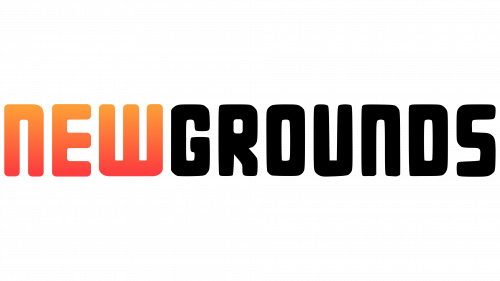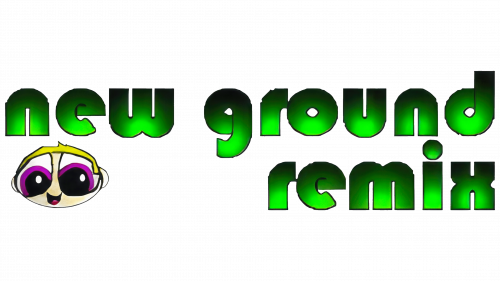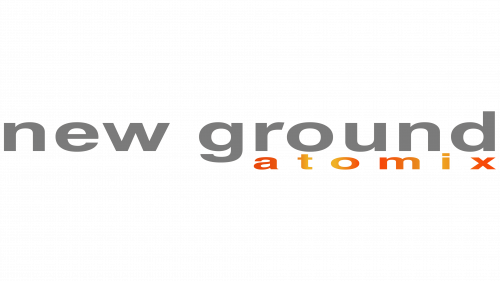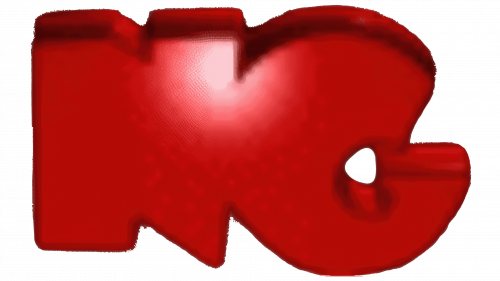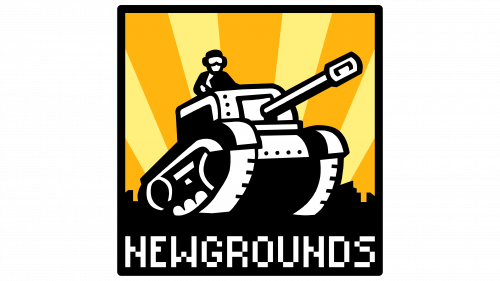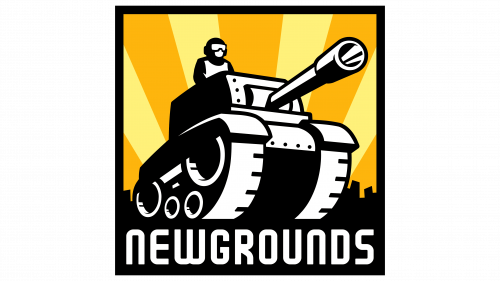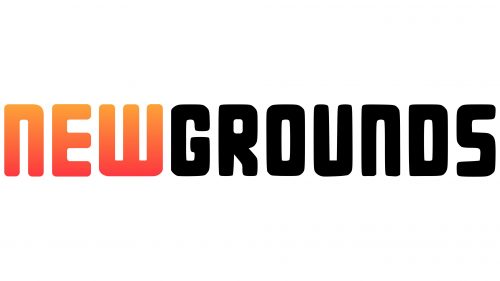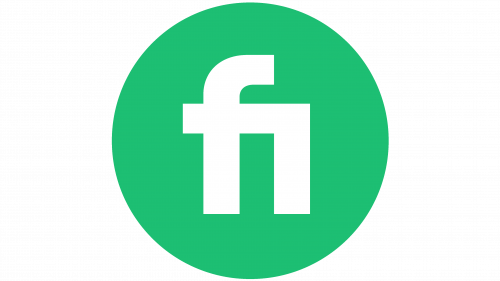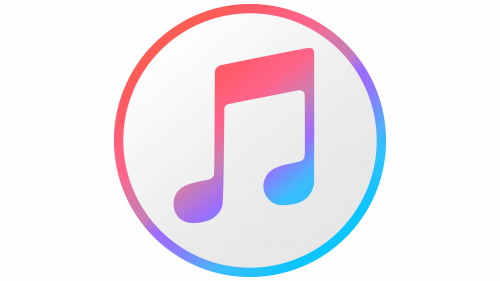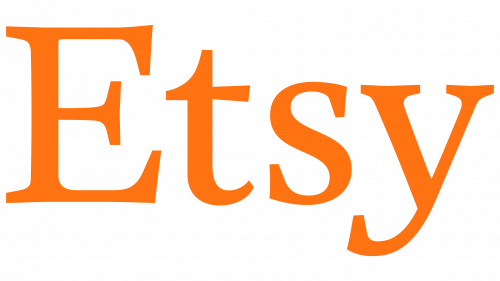The Newgrounds logo perfectly conveys the platform’s dynamic and innovative spirit. Its design exudes energy, creativity, and warmth, fully aligning with the concept of a portal created to inspire and support creative people. The emblem symbolizes the idea of a modern digital space that is actively evolving, attracting more users ready to share their ideas and projects.
This visual symbol represents the platform’s vibrant and inspiring atmosphere for its participants, turning it into a place where creative individuals can connect, grow, and bring their ideas to life.
Newgrounds: Brand overview
Newgrounds’ story began in 1995 when Tom Fulp, a teenager, created a small website called “New Ground Atomix.” Initially, it was an AOL-distributed newsletter focused on video games and the Neo Geo system.
In 1996, Tom moved the project to its domain, launching Newgrounds.com. At first, the site featured mostly animations and games created by Fulp himself, including his popular “Assassin” series.
A pivotal moment came in 1997 when Tom released his first Flash game, “Club a Seal,” which quickly attracted significant user attention. This set the platform’s future direction as a space for hosting Flash content.
In 1998, the website introduced the “Portal” system, allowing users to upload Flash animations. This innovation transformed it from a personal project into a legitimate space for artistic expression. Between 1999 and 2000, the site experienced rapid growth as people began contributing their own Flash animations and games. A rating and review system was implemented during this period, allowing the community to score content.
In 2001, the “Audio Portal” was launched. It enabled musicians to upload their music for animations and games, fostering a unique collaborative environment.
From 2002 to 2003, the “Tank Awards,” an annual prize for the best content creators on the site, was introduced. The addition of a forum became an essential part of the community.
In 2004, the site implemented stricter quality standards for uploaded content and enhanced its moderation system, improving content quality.
Major technological advancements were made between 2005 and 2006. The platform expanded its social interaction features, improved file uploads, and introduced new tools for creators. In 2007, a monetization system was launched, allowing creators to earn income through sponsorship and advertising, attracting even more talented creators.
With the rise of mobile gaming in 2008 and 2009, the site responded by supporting new formats and technologies.
In 2010, the platform reached 2.5 million users and continued to add tools for content creators, improving site navigation and search functionality.
The years 2011 and 2012 were marked by adapting to changes in web technology, supporting HTML5 content in preparation for Flash’s eventual discontinuation.
In 2013 and 2014, an Art Portal for illustrations and static images was added, attracting a new audience of visual artists.
Between 2015 and 2016, the site focused on platform updates, improving the mobile version, adding new tools for creators, and enhancing its recommendation algorithm.
After the announcement that Flash support would end in 2017–2018, efforts were made to preserve legacy content by developing a custom Flash player.
Between 2019 and 2020, the site underwent a major redesign, transitioning to modern web technologies while continuing to support older Flash content through its custom emulator.
From 2021 to 2022, the platform continued to evolve as a space for independent creators, embracing new formats and technologies while preserving its unique culture and community.
Throughout its history, the website has remained committed to providing independent creators a space for artistic expression. It became a launchpad for many well-known animators and developers, playing an essential role in developing web animation and independent games.
Meaning and History
What is Newgrounds?
This is an innovative entertainment platform and creative community where artists, animators, musicians, and game developers share their original works, from amusing Flash animations to indie games and music. The platform serves as a launching pad for emerging digital artists and is a repository of user-generated content. Community ratings and comments help highlight the best works and encourage creator collaboration.
1991 – 1995
The logo is done in black and white tones using grotesque grunge-style letters, giving it a bold and rebellious character. The name suggests creating a new world, a new “ground,” where entertainment and creativity reign. It first appeared in 1991 when the future founder of the platform, at just 13 years old, sent it to the subscribers of his amateur online publication.
The logo’s text alternates between white and black, large and small letters, symbolizing the contrasts of life: ups and downs, light and dark moments, victories and defeats. This style emphasizes the variety of content featured on future platforms.
Behind the letters “N” and “U” are rectangles resembling banknotes or mirrors. These elements highlight the platform’s two main areas of focus—games and animation—emphasizing the importance of each and creating an association with creative possibilities and financial independence.
1995 – 1997
In 1995, an official professional website called New Ground Remix was launched, continuing the development of the original idea. At that time, college student Tom Fulp aimed to create a platform for games, which became the foundation for the project’s future success.
The site’s emblem is designed in a UFO style, adding a touch of fantasy and mystery. The green text, covered with a light gradient, looks as if it’s made of cosmic slime, giving the logo a unique and playful feel. In the bottom left corner is a cheerful humanoid’s head, which resembles a cartoon seal. This character is connected to one of the first games on the platform—”Club a Seal”—highlighting its historical significance and a sense of nostalgia for early projects.
1997 – 1998
When the site started to gain recognition and popularity, the first and second parts of famous games like Club a Seal and Assassin were released. These projects played a key role in establishing the platform, providing a space for creativity among other developers. Riding this wave, New Ground Atomix hosting was launched, allowing creators to upload their games and applications. This platform quickly became a space where developers could share their ideas and projects, promote them, and receive feedback.
The hosting emblem was minimalist and strict, giving it a unique elegance. The lowercase gray inscription “New Ground” symbolized the foundation, the very space where work on games and applications took place. This name metaphorically conveyed the idea of soil or a platform where ideas are nurtured and developed, eventually turning into final products. Below this reserved inscription was the word “Atomix,” designed with a fiery red-orange gradient. This bright element symbolizes the creative impulse, the spark from which new ideas and inspiration for unique projects are born.
1998 – 1999
The animated logo, composed of large initial letters of the name, looks impressive and commanding. The red color emphasizes its creative potential and highlights the platform’s growing popularity. This image is closely connected with the development of the game *Pico’s School*, which amazed users with its complex structure and meticulous attention to detail. This project became a significant milestone for the platform, solidifying its position in the market as a serious player in the gaming industry. The emblem vividly reflects this achievement, showcasing New Ground’s importance in-game and application development.
1999 – 2000
The red letters look like they were cut out of clay, giving them a distinctive texture. This unusual presentation emphasizes the emblem’s uniqueness and adds style and avant-garde qualities. Above these large letters, the full brand name is neatly written in thin black font. This design evokes the aesthetics of superhero comics due to its dynamism and expressiveness. The changes directly relate to merging the site and hosting under a single domain name. This fact is vividly demonstrated by a unified inscription that connects the two background letters, symbolizing a new era for the brand.
2000 – 2000
In 2000, The Portal appeared, allowing users to automatically upload their games and allowing every visitor to rate them. This innovation made the platform more accessible and interactive for a wider audience. Along with the launch of The Portal came the brand’s symbol—the superhero Tankman (Sergeant John Captain), who became the face of the project. Andrew J. Brozyna created the logo, and it looks like a square icon featuring a tankman riding a tank in the sun’s rays. Over time, this image evolved into the main character of the web series “Tankman,” further strengthening its connection to the brand.
On a black background, the bottom of the square icon is a white inscription with the portal’s name written in capital letters. This design is associated with the visual aesthetics of games, giving the logo the feel of a game icon. All these elements create a recognizable and striking image that has established itself as the symbol representing the platform and its community of developers and players.
2006 – 2018
In 2006, the series “Tankman,” created by Johnny Utah, was released, and at the same time, the iconic logo underwent some minor changes. The image of the tank became closer and larger, giving it a more powerful visual impact. The tank’s turret is slightly turned towards the viewer, creating a sense of movement. The character on the tank continues to stare intently forward, fully focused on his direction, emphasizing determination. The tank’s barrel has been rendered with greater detail, clearly showing the muzzle, adding a sense of threat and power to the image.
Additionally, the number of wheels inside the tracks increased, making the tank taller and giving the machine a more imposing appearance. The composition now looks majestic, highlighting the project’s scale and significance. The emblem evokes a sense of grandeur and strength, fully reflecting the platform’s development and progress. The portal’s letters have become smoother and neater, reflecting the site’s evolution as it continues to improve while the quality of uploaded content consistently rises. These changes convey that the project has become more mature and professional while retaining its core idea and spirit.
2018 – today
The portal’s logo has become more modern and relevant with the transition of game formats from Flash to HTML5. The new emblem takes on a textual form, where every detail holds significance. The first part of the inscription is designed in a red-orange gradient, symbolizing the freshness of ideas and the creative potential of all project participants. This gradient highlights the energy that fuels the platform and inspires developers to create new solutions.
The color of the word “Ground” is associated with the earth, symbolizing a solid foundation for growth. The letters have rounded yet strong and confident shapes, visually reflecting the balance between the accessibility of innovations and the platform’s user-friendliness. These shapes symbolize openness to new ideas and technologies and a simplified interaction process with the resource, making it appealing to a wide audience.
These changes in the Newgrounds logo reflect the platform’s technical updates and evolution, becoming more flexible and modern while remaining true to its core mission—supporting creativity and innovation.
